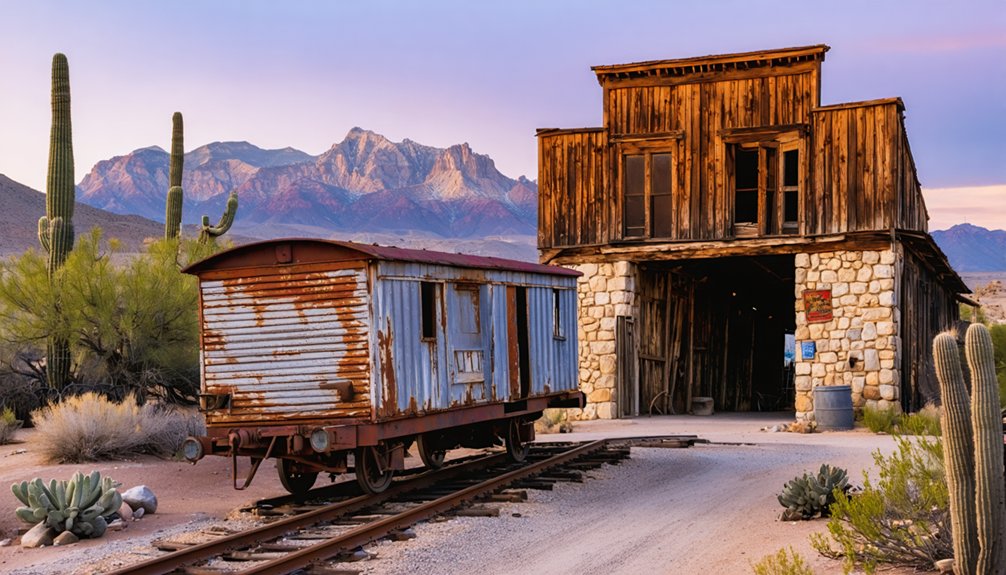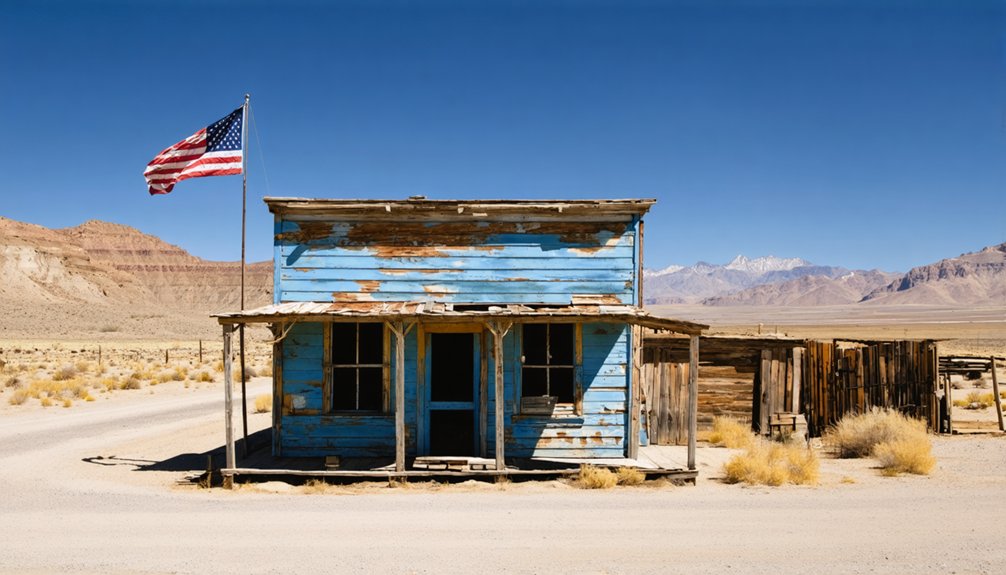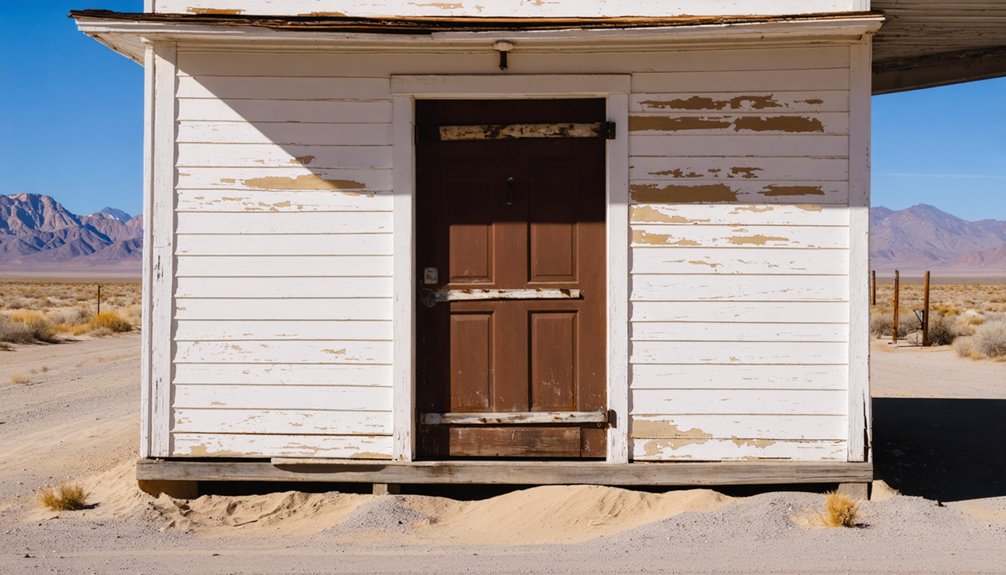Chloride, Arizona isn’t a true ghost town, but a living relic of Arizona’s silver mining heyday. Founded in 1863, it once boomed with 5,000 residents and 75 active mines before declining post-WWII. Today, about 250 residents maintain this historic settlement featuring original structures, Roy Purcell’s famous psychedelic murals, and remnants of the Tennessee Mine. You’ll find both preserved mining heritage and modern desert community thriving among the Cerbat Mountains.
Key Takeaways
- Chloride is Arizona’s oldest continuously inhabited mining town, established in 1863, with a population that once peaked at 5,000 during the silver boom.
- Despite being called a “ghost town,” Chloride maintains a small population of 120-295 residents, primarily retirees with a median age of 76.5 years.
- Historic structures including the original 1873 post office and 1898 Santa Fe Railroad station preserve the town’s mining heritage.
- Roy Purcell’s “The Journey” murals, spanning 2,000 square feet of boulder canvas, serve as a defining cultural landmark attracting visitors.
- The town experienced its heyday with over 75 active mines, with the Tennessee Mine becoming Arizona’s largest silver producer.
The Silver Rush That Built Chloride
When silver was first discovered in the Cerbat Mountains in the early 1860s, it sparked what would become one of Arizona Territory’s most significant mining booms. Prospectors uncovered rich veins at Silver Hill, finding not just silver but also gold, lead, zinc, copper, and turquoise.
By 1863, these discoveries led to the founding of Chloride, a town named for the silver chloride mineral abundant in the area.
Miners christened their frontier settlement Chloride, honoring the gleaming silver chloride that promised fortune in Arizona’s rugged hills.
Early silver extraction faced setbacks due to conflicts with Hualapai Indians, but after treaties in 1870 and 1873, mining operations surged. Over 75 mines soon dotted the Cerbat range, with the Tennessee Mine emerging as the top producer.
This mining heritage transformed Chloride from a remote outpost into Mohave County’s largest settlement, briefly serving as the county seat. At its peak, the town’s population reached 5,000 residents before declining in later years. The arrival of the Santa Fe Railroad in 1898 significantly boosted mining operations by reducing transportation costs for the ore.
From Mining Camp to Thriving Community
The silver boom that established Chloride quickly transformed the once-primitive mining camp into a proper frontier town with permanent structures and civic institutions.
By 1873, the establishment of a U.S. Post Office signaled the community’s permanence, becoming one of Arizona’s oldest continuously operated post offices after reopening in 1893.
Transportation networks fueled growth with the Butterfield Stage Line serving the town from 1868 to 1919, while the 1899 arrival of the Arizona and Utah Railway connected Chloride to Kingman.
At its peak, the town boasted 5,000 residents and over 75 active mines, making it Mohave County’s largest settlement and county seat.
Despite early conflicts with the Hualapai, community resilience prevailed.
The town developed shops, restaurants, and social services while preserving its cultural heritage through historic buildings and miners’ graves—testaments to Chloride’s frontier spirit.
Mining operations expanded significantly in the 1870s after the community established a treaty with Hualapai Indians, allowing for peaceful development of the area’s rich mineral deposits.
The Golconda Mine became particularly significant to Chloride’s prosperity, producing an estimated six and a half million dollars in ore during the town’s golden era.
Conflict With the Hualapai: a Troubled Beginning
Before Chloride could flourish as a mining town, violent conflict with the indigenous Hualapai people dominated the area’s early history. The trouble began in 1860 when Hualapai warriors killed four of six miners who entered their territory. This marked the beginning of years of bloodshed.
Hualapai resistance intensified as settler encroachment increased:
- Gold discovery in Prescott Valley (1863) brought waves of miners into traditional lands.
- New wagon roads cut through Hualapai territory, disrupting their way of life.
- The murder of Chief Anasa in 1865 sparked the five-year Hualapai War.
- One-third of the Hualapai population perished during the conflict.
The Hualapai employed effective guerrilla warfare tactics throughout the conflict, making strategic raids and cutting off access to important routes.
After numerous battles, the U.S. Army forced many Hualapai to move to Camp Beales Spring reservation when the war ended.
Only after the 1873 treaty could mining properly develop in Chloride, though the Hualapai continued to face displacement and pressure from expanding settlement.
Tennessee Mine and the Wealth Beneath the Surface
As you explore Chloride’s mining heritage, you’ll find the Tennessee Mine standing as the district’s largest operation and Arizona’s biggest silver producer.
The mine’s extensive deposits yielded millions in silver, zinc, and lead, maintaining production well into the 1940s even as other operations failed. The area’s rich geology features granite formations dating back to the Upper Cretaceous epoch.
Though operations ceased for decades, companies like Hondo Minerals have recently attempted to revive the Tennessee Mine, continuing its legacy as the centerpiece of Chloride’s mineral wealth.
Million-Dollar Silver Producer
Beneath the rugged terrain of the Cerbat Mountains lay a fortune in silver that would establish Chloride’s place in Arizona mining history.
The Tennessee Mine, developed after the 1873 treaty with the Hualapai, became Arizona’s largest silver producer, surpassing the Golconda’s estimated $6.5 million output.
When you explore Chloride’s mining legacy, you’ll discover four key aspects of the Tennessee Mine’s impact:
- Rich silver veins yielded unparalleled wealth using advanced mining techniques
- Produced substantial gold, lead, zinc, and turquoise alongside silver
- Operations continued into the mid-20th century, providing decades of prosperity
- Established Chloride as Arizona’s premier silver district
The mine’s extraordinary success drove population growth and infrastructure development, including the 1873 establishment of a U.S. Post Office.
The town’s name itself reflects its mining heritage, derived from Silver Chloride, a valuable product formed when silver combines with chlorine.
Modern efforts by Hondo Minerals are underway to revitalize the historic Tennessee mine site with new processing facilities and equipment.
Continuing Operational Legacy
The Tennessee Mine solidified its dominance in the Chloride mining district by 1910, when dedicated Santa Fe Railroad tracks connected it directly to the railway station for efficient ore transport.
While initially slowed by conflicts with the Hualapai Indians, mining activities expanded rapidly following a treaty in the early 1870s.
You’ll find the Tennessee Mine’s economic impact extended well beyond silver production. As the area’s most productive operation, it primarily extracted zinc and lead into the 1940s.
This operational longevity stemmed from the site’s diverse mineralization, linked to Late Cretaceous porphyry intrusion that created rich ore deposits.
The mine’s geological significance is enhanced by its ore body being hosted in gneiss formations that strike N20W and dip 68NE.
Though the mine’s eventual closure triggered population decline, the mineral legacy continues to influence regional interests.
Today, varying ownership between private entities and federal government still permits ongoing mineral exploration within this geologically significant district.
Roy Purcell’s Desert Murals: Art Among the Ruins

You’ll find Roy Purcell’s vibrant “The Journey” murals spanning 2,000 square feet of boulder canvas about 1.5 miles east of Chloride, painted in 1966 while he worked as a miner.
These psychedelic modernist paintings have survived the harsh desert conditions through multiple restorations, including a major 2006 effort that refreshed all 19 murals.
Though reaching the site requires traversing an unmaintained dirt road, the journey rewards you with an unexpected explosion of color amid the arid landscape, now a defining cultural landmark for this former mining town.
Psychedelic Desert Canvas
Hidden in the rugged hills just 1.5 miles east of Chloride, vibrant psychedelic images transform ordinary granite boulders into a striking outdoor art gallery.
Roy Purcell created “The Journey: Images From an Inward Search for Self” in 1966 while taking a break from mining work, covering 2,000 square feet of rock face with psychedelic symbolism that’s remained remarkably vivid through decades of desert exposure.
You’ll discover four distinct elements that define these murals:
- Spiritual imagery including fertility goddesses and Yin Yang symbols
- Local mining themes referencing the zinc-producing Tennessee Mine
- Dreamscape elements blending surrealism with mural techniques
- Natural integration with the rugged landscape enhancing the artwork’s impact
Purcell has retouched his creation twice—in 1975 and again in 2006—ensuring these psychedelic visions continue inspiring visitors seeking artistic freedom.
Preservation Amid Isolation
Surviving against harsh desert elements and decades of isolation, Roy Purcell’s psychedelic murals have endured as a tribute to artistic preservation in the remote Arizona wilderness. Since their 1966 creation on a 2,000-square-foot rock face near Chloride, these vibrant works have required dedicated maintenance to persist.
Purcell first returned in 1975 to repaint his creation, later leading a significant restoration in 2005-2006 with a team of artists using automobile paint for durability. Without official government oversight, the murals’ survival depends on informal care and Purcell’s commitment to his artistic vision.
The site’s cultural significance extends beyond aesthetics, incorporating local mining imagery and spiritual symbolism that connects visitors to the area’s rich history.
This remarkable achievement continues attracting art enthusiasts despite challenging access via unpredictable dirt roads.
Beyond a Ghost Town: Life in Modern Chloride
While Chloride holds the moniker of a ghost town, it continues to support a small but resilient population of permanent residents. With a median age of 76.5 years, Chloride’s community primarily consists of retirees living a quiet rural lifestyle.
Community engagement happens at a measured pace suited to the aging population, with elderly support naturally embedded in neighbors’ relationships.
Modern life in Chloride presents:
- A homogeneous population of around 120-295 residents, nearly all English-speaking and U.S. citizens
- Modest economic conditions with $35,900 median household income, yet zero recorded poverty
- Stable housing with 60% homeownership among approximately 71 family households
- Access to nearby urban amenities in Kingman and Lake Havasu City, balancing isolation with convenience
This small community preserves its freedom through independence and self-sufficiency despite demographic challenges.
Exploring Mining Relics and Historic Structures

Beneath Chloride’s weathered façade lies a treasure trove of mining relics and historic structures that tell the story of Arizona’s silver rush era.
You’ll find the Tennessee Mine, once Chloride’s top producer of silver, gold, and turquoise, among the 70-100 operations that dotted the Cerbat Mountains. Mining technology from this period is preserved in ore processing sites, documented through Northern Arizona University’s archaeological studies in 2003-2004.
The town’s community heritage earned recognition on the Arizona Register of Historic Places in 1998.
Don’t miss the original post office building dating to 1873—Arizona’s oldest continuously operating postal facility—and the 1898 Santa Fe Railroad station.
The Chloride Historical Society’s museum, built to resemble an Old West town, houses artifacts that illuminate daily life during the silver boom years.
Desert Adventures: 4WD Trails and Petroglyphs
Beyond Chloride’s historic streets, a network of rugged 4WD trails beckons adventure seekers into the surrounding Cerbat Mountains.
The Big Wash Road serves as your gateway, requiring a high-clearance 4×4 vehicle to navigate steep climbs, boulder-strewn paths, and hairpin curves with a 2,500-foot elevation gain.
During your petroglyph exploration, you’ll discover:
- Ancient Native American rock art etched on roadside boulders
- Roy Purcell’s vibrant 1966 murals painted near a cave where he once lived
- Panoramic desert vistas from Windy Point’s 6,000-foot elevation
- Abandoned mining ruins scattered throughout the 17.4-mile trail
Preserving Arizona’s Oldest Mining Settlement

Since its founding in 1863, Chloride has maintained the distinction of being Arizona’s oldest continuously inhabited mining town, nestled in the Cerbat Mountain Range at 4,000 feet elevation. Named for its silver chloride deposits, the settlement flourished with 70-100 mines operating during its peak, briefly serving as Mohave County’s seat.
The Chloride Historical Society champions preservation through its museum in Cyanide Springs, a replica Old West town built with lumber from the Golconda Mine. Their efforts highlight the town’s cultural significance while preserving mining architecture and artifacts from the 19th century.
Visit Cyanide Springs, where the Chloride Historical Society preserves the authentic essence of Arizona’s mining era through carefully restored artifacts.
Community engagement remains essential to maintaining historical structures like Arizona’s oldest continuously operating post office (est. 1893).
Despite challenges from fluctuating silver prices and environmental concerns, preservation initiatives continue to honor Chloride’s complex mining heritage.
Frequently Asked Questions
Is Paranormal Activity Reported in Chloride’s Abandoned Buildings?
You won’t find documented ghost sightings in Chloride’s abandoned buildings. Unlike Arizona’s truly haunted towns like Jerome, Chloride’s eerie charm comes from its preserved mining relics, not a paranormal history.
What Happened to Chloride During Prohibition?
During prohibition, you’d have seen Chloride’s decline accelerate as mining operations dwindled. The town’s population continued shrinking, with prohibition’s impact likely mirroring national trends in this remote, fading frontier community.
How Did the Great Depression Affect Chloride?
You’ll find the Depression devastated Chloride with severe economic decline. By 1931, half the businesses stood vacant, the post office closed, and mining operations collapsed. The railroad’s 1935 closure sealed the community’s fate.
Are There Guided Tours or Annual Festivals in Chloride?
You’ll find guided explorations from Las Vegas that include Chloride’s historical significance. The town hosts bi-monthly gunfight reenactments, Saturday karaoke, and museum openings, rather than major annual festivals.
Can Visitors Pan for Gold or Minerals Today?
You can try gold panning during Old Miners’ Day in October, but there aren’t regular opportunities for mineral exploration. Contact the Historical Society for event dates or nearby alternatives.
References
- https://www.legendsofamerica.com/az-chloride/
- https://www.atlasobscura.com/places/chloride-ghost-town
- https://www.vvdailypress.com/story/lifestyle/2024/04/25/chloride-arizona-is-just-more-than-a-trip-to-a-chemical-town/73429741007/
- https://www.youtube.com/watch?v=6agjl7Yxkdc
- https://www.chlorideaz.com/history
- https://www.visitchlorideaz.com/history
- https://www.swtimes.com/story/lifestyle/travel/2020/11/14/chloride-arizona-friendly-living-ghost-town/43146545/
- https://westernmininghistory.com/towns/arizona/chloride/
- https://architecturalafterlife.com/2024/02/exploring-the-ghost-town-of-chloride-arizona/
- https://www.hmdb.org/m.asp?m=31845



